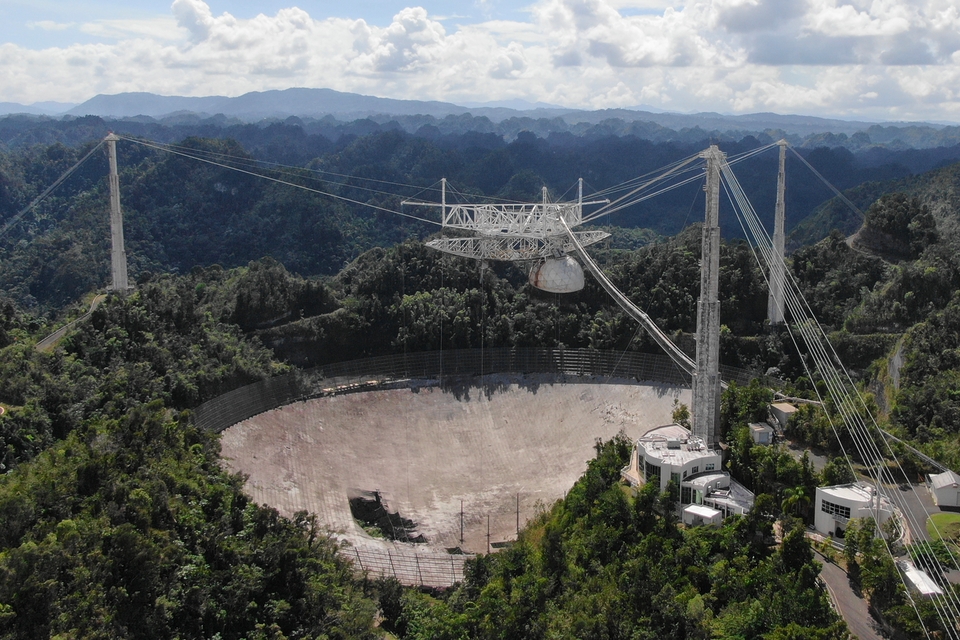The battered radio telescope – which starred in the film ‘Contact’, among other things – will no longer be repaired, but will be dismantled.
After an important cable came loose in August and caused considerable damage to the radio telescope, things went wrong again at the beginning of this month. A second cable broke in half and also caused damage to the telescope. Earlier this week it became clear how serious the situation was when it became known that the telescope could collapse without intervention. The future of the radio telescope hung by a thread. And it has just become known that the real end of story. The famous radio telescope that has led to so many beautiful discoveries is being dismantled.
Great discoveries
And with that comes an end to an era that began in the 1960s. Then they started building a huge radio telescope near the town of Arecibo in Puerto Rico.
The telescope is only just finished, when researchers use it in 1964 to determine the rotation time of Mercury. Later it will appear that the radio telescope has a lot more to offer. This is how it is with this radio telescope that in the decades that followed, the first exoplanets were discovered, the existence of neutron stars was shown, the first repetitive fast radio flash spot and proved that the poles of Mercury have ice. To top it all off, the radio telescope plays a central role in the search for extraterrestrial life. For example, the telescope is used to detect possible extraterrestrial radio transmissions and was also used in 1974 to send a radio message to possible intelligent civilizations in the globular star cluster M13.
Issues
It should be clear: the Arecibo radio telescope – which also starred in the well-known film ‘Contact’ and even appeared in a Bond film in the last century – has a rich history. But it is not all roses and moonshine. Since it was founded more than fifty years ago, the telescope has also experienced many hurricanes, tropical storms and earthquakes, which did not always leave the observatory in the cold clothes. There have also been regular financial worries, especially in recent decades, and around 2006 it even seemed as if it should close in the near future. But the funding was secured and the telescope was saved again.
The Arecibo Radio Telescope is located in Puerto Rico and was built in the 1960s. The telescope consists of a 305-meter-wide dish that is made up of more than 38,700 panels. Above this dish hangs a 900 ton heavy platform with the receiver on top. This platform is suspended from 18 cables that are connected to three towers. This photo was taken in November. Image: University of Central Florida.
–
Few will have seen this summer that 2020 would eventually be the year in which the curtain really falls for the Arecibo radio telescope. Because until August there was not much to worry about. Some repairs were made due to damage sustained to the telescope in 2017 by Hurricane Maria, but there was no indication that the telescope was working on its latest achievements. And then disaster strikes in early August. One of the cables of the 900-tonne platform that hangs above the dish shoots loose and punches a 30-meter hole in the dish.

The hole punched in the dish in August. Image: Arecibo Observatory.
–
An investigation immediately followed into the cause of the disconnection of this cable and the condition of the remaining cables. And by the beginning of November, sufficient information had been gathered to start the repair work. But the mechanics had not started yet or things went wrong again. A second cable – attached to the same tower as the cable that came loose in August – broke right in half. It can probably be traced back to the fact that this cable had more weight to bear due to the incident in August.

Here you can see the cable that broke in November. The photo was taken by a drone. Image: Arecibo Observatory.
–
Setback
A huge setback, said Francisco Cordova, director of the observatory, shortly after the second cable was broken. “This is certainly not something we want to see (…) We had properly assessed the situation (…) and made plans for repairs. And now this. ” Last week, however, it became really clear how dire the situation was. After research, engineers could not guarantee that the remaining cables could keep the 900-tonne platform in the air. “Each of the remaining cables now carries more weight than before, increasing the chances of another cable breaking and likely resulting in the entire structure collapsing,” the company said. University of Central Florida that the telescope together with the National Science Foundation (NSF) manages.
More research followed and, according to NSF, it showed that the radio telescope cannot be saved without endangering the lives of the repairers. An analysis of the cable that broke in November showed that this cable was in much worse shape than assumed and it does not seem inconceivable that the same applies to the other cables. And with that, the chance that the platform will still come down during repair work is simply too great. “Ultimately, the data showed that we simply couldn’t do this safely,” said Ralph Gaume, on behalf of NSF. And with that, after almost six decades, the curtain falls for the Arecibo radio telescope. In order to prevent the telescope from unexpectedly collapsing under its own weight, the aim is to dismantle it in a controlled manner in the coming period. It is still unclear how much time that will take.
–
Keep amazed ✨
Receive the most beautiful space photos and interesting popular science articles every Friday. Get the free Scientias Magazine together with 50,000 others.


